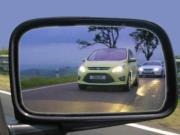At some point in the training of many pupils it becomes necessary to explain how the gears work. Sometimes you can do it during the controls lesson – I usually mention it briefly then – but it often makes more sense to them once they have got a basic understanding of how to make the car move. Horses for courses, as the saying goes – you adapt your lesson to the needs of the individual.
Anyway, it seems that a lot of instructors don’t go into detail at all (and that includes how the clutch works). Not having had something explained to them – whatever it is – is usually why someone is having difficulty with it a long way into their training. As far as they’re concerned, they “aren’t progressing”, so they jump ship and find another ADI.
I’ve put this little animation together to help explain how gears work. If you want to play along, don’t fiddle with it until you read the explanation that goes with it. (Sorry, this post was written a long time ago before Flash was discontinued. I’ve only just rediscovered it, so I will find a replacement shortly)
In the animation above you can see the drive gear rotating. This is connected through the clutch to the engine, so if you put more gas on it goes faster (and if you slip the clutch it will go slower).
Click the “1st” button and the first gear appears – this is connected to the wheels, and when it goes round so do the wheels. In this demonstration it’s exactly the same size as the drive gear, so for each revolution of the drive gear the first gear will also revolve once (the red marker dots show the movement). You can get moving easily, but if you want to go faster after that you need to change up.
Click on the “2nd” button and the second gear replaces first. The second gear is smaller than first and for each revolution of the drive gear it will go round 1.25 times in this demonstration. By moving to this gear once the car is moving you’ll maintain your previous speed and be able to accelerate more without the engine having to do so much work.
Click on the “3rd” button and the third gear replaces second. This gear is even smaller than second and for each revolution of the drive gear it will revolve 1.7 times in this demonstration. This will allow you to accelerate even more.
Click on the “4th” button and fourth gear replaces third. This gear is smaller still and for each revolution of the drive gear it will go round 2.5 times in this demonstration. If we assume this is the top gear, this will allow you to travel at the highest speed for your car. Obviously, that means safe speed – not necessarily the maximum speed.
Click on the “All” button and all the gears are visible. See how the marker dots all move at different speeds.
Now, you have to remember that the car weighs quite a bit – typically, about 1 metric tonne – and it takes a lot of effort to get this moving. You need as much power from the engine as you can get to start moving before you move up through the gears as you gain speed. You can get that initial power transfer using first gear.
If you choose a higher gear than 1st, each revolution of the engine has to move the car by the equivalent of more than one revolution of the chosen gear (in the demonstration), and if you are going too slow it will be too much and for the engine and it will stutter or stall. But in first gear, one revolution of the engine will move the car by the equivalent of one revolution of that gear. That requires much less effort by the engine.
The demonstration is not intended to represent actual gear sizes and ratios in a real car. It just shows how different sized gears work.
Going into too much detail is a double-edged sword – both edges of which are nasty! You will either bore the pants off 75% of your pupils, or get caught out when it turns out 5% are mechanics and know more about the gears than you do. The other 20% might just be getting too much information – information that they don’t need, but are paying for.
ADIs are supposed to teach people how to drive – not how to strip down a gearbox. Keep it simple, keep it focused, and keep it sensibly brief.
Addendum: In spite of pointing out that the above explanation is not intended to represent the exact gear ratios in a car, and that it is intended as a brief explanation for pupils about how gears work, there are still some people out there eager to put down this advice and point out that the gears are different sizes and ratios in a real car. Yes, I know. I said that already.
But for anyone who still believes that it is an instructor’s job to give physics and engineering lessons as well as driving tuition, and who is desperate to shoot holes in this tutorial, the gear ratios in the simple demonstration above came about because I started with a 25-toothed gear and went down in 5-tooth steps. They ended up as:
- 1st – 1:1
- 2nd – 1:1.25
- 3rd – 1:1.7
- 4th – 1:2.5
These numbers of teeth were chosen purely to get an animation that wasn’t too complicated, but which showed how the gearing works when moving any vehicle. In a current Ford Focus, the actual ratios are:
- 1st – 3.67:1
- 2nd – 2.14:1
- 3rd – 1.45:1
- 4th – 1.03:1
- 5th – 0.81:1
- Reverse – 3.73:1
- Final drive – 3.82:1
In other words, the drive gear is smaller than 1st, 2nd, and 3rd gears. Of course, the ratios will be different for all other Ford models (including the various Focuses), and for all other makes and models. And if you want to go still further, you could use this information to calculate the distance moved per engine revolution as long as you know the exact circumference of the tyres and then get on to the effect the differential gears have on the final power yield. Your pupils will marvel at your erudition on the subject!
I’ve got one girl who gets bored within 5 seconds if I pull her over to discuss why she tried to drive us off a cliff, and I don’t think I’ve yet come across anyone – even those studying physics at Uni, or who are apprentice car mechanics – who feel they’re paying me to lecture them on this topic.
If you’re going to lecture on something, the more detail you go into the more of an expert you need to be. Driving instructors need to recognise where their “skills” end and “nit-picking” begins.
 The story refers to Colin Horsfall – the driver in question – but also to the case of 87-year old Richard Bradley who only got points for driving into a woman suffering from MS. Helen Harrington, who was the woman knocked down, is also calling for re-testing.
The story refers to Colin Horsfall – the driver in question – but also to the case of 87-year old Richard Bradley who only got points for driving into a woman suffering from MS. Helen Harrington, who was the woman knocked down, is also calling for re-testing.



 The existing network is known as Phase I. Phase II began several months ago and was flagged in advance by the usual “Expect Delays” signs erected by the jubilant council and contract workers. The first of these appeared along University Boulevard ahead of cutting down most of the trees.
The existing network is known as Phase I. Phase II began several months ago and was flagged in advance by the usual “Expect Delays” signs erected by the jubilant council and contract workers. The first of these appeared along University Boulevard ahead of cutting down most of the trees.
 Taking my own pupils as an example, a typical 2 hour lesson can cover anywhere from less than 5 miles to more than 60! It just depends on what you are trying to cover.
Taking my own pupils as an example, a typical 2 hour lesson can cover anywhere from less than 5 miles to more than 60! It just depends on what you are trying to cover. out how much it will cost them to learn to drive, and I make it clear from the outset that if they can get a lot of quality private practice between lessons then they will learn over a shorter time period. I just tell them straight that if they can get insured on mum or dad’s car then that will avoid having to pay me for the road time instead. I also tell them that it is important that mum or dad prevents bad habits forming, so I suggest that they accompany us on a lesson and I show them some things to watch out for.
out how much it will cost them to learn to drive, and I make it clear from the outset that if they can get a lot of quality private practice between lessons then they will learn over a shorter time period. I just tell them straight that if they can get insured on mum or dad’s car then that will avoid having to pay me for the road time instead. I also tell them that it is important that mum or dad prevents bad habits forming, so I suggest that they accompany us on a lesson and I show them some things to watch out for. I noticed recently someone was giving ridiculous advice about stopping in the cyclists’ forward area. Perhaps they should read this and learn.
I noticed recently someone was giving ridiculous advice about stopping in the cyclists’ forward area. Perhaps they should read this and learn.